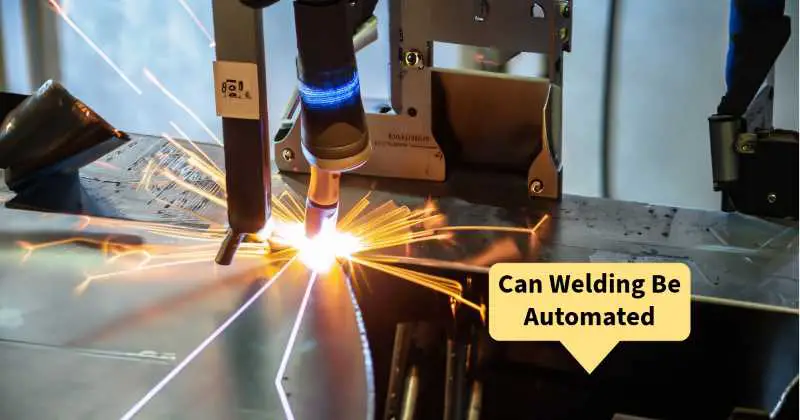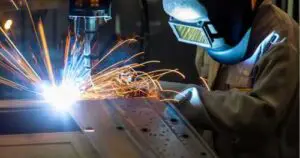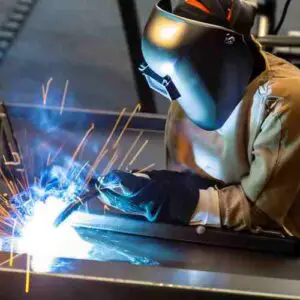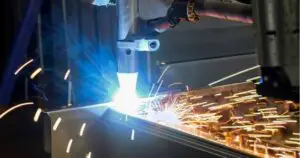Table of Contents
- The Rise of Automated Welding
- Can Welding Be Automated?
- Advantages of Automated Welding
- Types of Automated Welding
- Factors Influencing Automation
- Challenges in Implementing Automated Welding
- The Future of Welding: Humans and Machines Collaborating
- Industries Embracing Automated Welding
- Environmental and Quality Benefits
- The Pros and Cons of Automated Welding
- Will Welding Become Automated?
- Why is Welding Not Automated?
- How Do You Automate a Welding Process?
- What is Automatic Welding?
The Rise of Automated Welding
In recent years, automated welding systems have gained traction across industries that require precise and repetitive welding tasks. These systems utilize advanced robotics, computer numerical control (CNC) systems, and artificial intelligence to execute welds with remarkable accuracy.
Can Welding Be Automated?
Welding, a crucial process in manufacturing and construction, involves joining materials through melting and fusing. The question arises: can welding, a skill traditionally associated with human expertise, be automated? The answer is a resounding yes. Thanks to advancements in robotics, artificial intelligence, and automation technology, welding can indeed be automated to a great extent.
Automation in welding involves the use of robotic systems to perform welding tasks with precision and consistency. These systems are programmed to manipulate the welding torch, control parameters like heat and speed, and execute welds with minimal human intervention. The result is increased accuracy, reduced human error, and enhanced efficiency.
Advantages of Automated Welding
Enhanced Precision and Consistency
Automated welding eliminates the variability associated with human factors. Robots and automated systems follow programmed instructions meticulously, ensuring consistent weld quality across numerous pieces.
Increased Efficiency and Productivity
Automated systems work tirelessly, 24/7, without breaks or fatigue, significantly boosting production rates. This leads to faster project completion and enhanced overall efficiency.
Improved Safety
By relegating hazardous welding environments to automated systems, the safety of human welders is elevated. Dangerous tasks like working in confined spaces or handling toxic fumes are now managed by machines.
Cost Savings
While the initial investment in automated welding systems can be substantial, the long-term benefits far outweigh the costs. Reduced rework, minimal material wastage, and increased output contribute to substantial cost savings.
Types of Automated Welding
Robotic Welding
Robotic arms equipped with welding tools can precisely manipulate weld joints, accommodating complex geometries and tight spaces.
Automated Laser Welding
Laser welding systems utilize high-energy laser beams to fuse metals together, providing a non-contact and highly accurate welding method.
Electron Beam Welding Systems
Electron beams generate intense heat, allowing for deep and narrow welds in aerospace and automotive applications.
Factors Influencing Automation
Complexity of Welding Operations
Highly intricate welds may require the dexterity and precision of human welders, making full automation challenging.
Material Variability
Automated systems excel when working with uniform materials but may struggle with variations in material properties.
Joint Designs
Complex joint configurations can pose a challenge for automation, as robotic systems might find it difficult to access certain angles.
Challenges in Implementing Automated Welding
Initial Investment
Acquiring and setting up automated welding systems can be expensive, deterring some companies from embracing automation.
Programming and Maintenance Costs
Continuous training of automated systems and addressing technical glitches incur additional expenses.
Skilled Workforce Transition
As automation takes over repetitive tasks, the need for skilled human welders may decrease, leading to workforce concerns.
The Future of Welding: Humans and Machines Collaborating
Rather than replacing human welders, automation is likely to result in a symbiotic relationship where humans oversee, program, and maintain automated systems.
Industries Embracing Automated Welding
Automated welding has found applications in the automotive, aerospace, electronics, and shipbuilding industries, among others.
Environmental and Quality Benefits
Automated welding reduces material waste, energy consumption, and emissions, contributing to a greener manufacturing process.
The Pros and Cons of Automated Welding
Pros:
1. Enhanced Precision and Consistency
Automated welding systems offer unparalleled precision. They can consistently execute welds with the same level of accuracy, minimizing the chances of defects. This is especially crucial in industries where structural integrity is paramount.
2. Increased Productivity
Automated welding can significantly boost productivity. Robots equipped with welding arms can work tirelessly, 24/7, without the need for breaks, ultimately leading to faster project completion.
3. Improved Safety
Welding can expose human welders to hazardous fumes and intense heat. By automating the process, the risk to human workers is reduced, leading to a safer working environment.
Cons:
1. High Initial Investment
Setting up automated welding systems requires a substantial initial investment. The costs include purchasing equipment, programming, and training personnel to operate and maintain the machinery.
2. Complexity of Programming
Programming welding robots to adapt to different materials, joint configurations, and welding techniques can be intricate. Skilled programmers are needed to ensure optimal performance.
3. Limited Versatility
Automated welding systems excel in repetitive tasks on standardized components. However, they may struggle with the flexibility required for intricate, one-of-a-kind projects.
Will Welding Become Automated?
The future of welding holds immense promise for automation. As technology continues to advance, the trend toward automation in various industries becomes more apparent. The same applies to welding. While welding has traditionally been a skill performed by skilled human welders, the integration of robotics, artificial intelligence, and automation technology has paved the way for automated welding processes. This evolution is driven by the pursuit of higher precision, efficiency, and safety in manufacturing and construction. Automated welding systems offer the potential to revolutionize the welding landscape, making it highly likely that welding will indeed become more automated in the coming years.
Why is Welding Not Automated?
Despite the rapid progress in welding automation, there are factors that contribute to the limited adoption of fully automated welding processes in certain scenarios. One primary reason is the complexity and variability of welding tasks. Welding often involves intricate geometries, varying materials, and unique joint configurations. Programming robotic systems to handle such diverse tasks requires time, expertise, and significant investment. Additionally, some specialized welding techniques demand the fine touch and judgment of experienced human welders, making full automation challenging. Moreover, the initial costs associated with acquiring and implementing robotic welding systems can deter businesses, especially smaller ones, from embracing automation.
How Do You Automate a Welding Process?
Automating a welding process involves a series of steps that merge technology with craftsmanship. The process typically includes:
- Assessment: Evaluate the feasibility of automation for the specific welding task, considering factors such as joint design, material type, and required precision.
- Programming: Skilled technicians program the robotic system by defining welding paths, parameters, and sequences. This step requires a deep understanding of both welding techniques and automation technology.
- Integration: Integrate the robotic system with necessary peripherals like welding torches, sensors, and safety mechanisms. This step ensures that the system operates seamlessly within the manufacturing environment.
- Testing and Calibration: Thoroughly test and calibrate the automated welding system to ensure accurate positioning, consistent parameters, and reliable performance.
- Training: Train operators to oversee and maintain the automated welding system. This includes troubleshooting, minor adjustments, and routine maintenance.
- Quality Control: Implement quality control measures to monitor and assess the weld quality produced by the automated system, ensuring it meets established standards.
What is Automatic Welding?
Automatic welding, often referred to as automated welding, is a process where welding tasks are carried out by robotic systems without extensive human intervention. These systems are programmed to execute welding operations with precision and consistency. Automatic welding systems typically consist of robotic arms equipped with welding torches, sensors, and controllers. These components work in tandem to manipulate the welding torch, control parameters such as heat and speed, and deliver accurate and repeatable welds. The goal of automatic welding is to enhance efficiency, reduce human error, improve safety conditions, and deliver high-quality welds across a range of applications, from manufacturing to construction.
The integration of automation technology into the welding process signifies a significant advancement in the field, promising increased productivity, reduced costs, and enhanced overall quality. While fully automated welding may not be feasible for all tasks, the continuous development of robotics and AI holds the potential to automate an increasing number of welding processes in the future.
Conclusion
In conclusion, the question of whether welding can be automated is not a simple yes or no. Automated welding offers undeniable benefits in terms of precision, efficiency, safety, and cost savings. However, challenges such as initial investment, technical complexities, and the evolving role of human welders must be carefully considered. As industries continue to advance, the collaboration between humans and machines in the welding realm seems to be the path forward.
FAQs about Welding Automation
- Is automated welding as precise as manual welding? Automated welding often surpasses manual welding in precision due to its programmed nature.
- What are the key advantages of robotic welding? Robotic welding offers enhanced precision, efficiency, and safety by minimizing human involvement in hazardous tasks.
- Will automated welding lead to job loss among human welders? While some tasks may be automated, human welders will still be needed for complex welds, system programming, and maintenance.
- Are there limitations to the materials that can be welded using automated systems? Automated systems work best with uniform materials, but challenges arise with varying material properties.
- How does automated welding contribute to sustainability? Automated welding reduces material waste, energy consumption, and emissions, aligning with environmentally conscious manufacturing practices.




2 thoughts on “Unveiling the Future: Can Welding Truly Be Automated?”